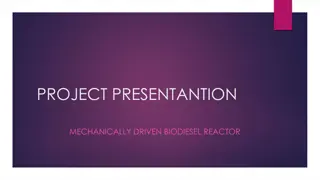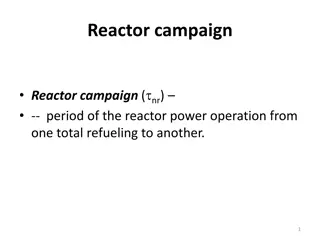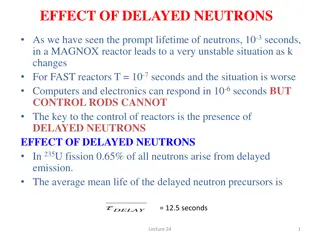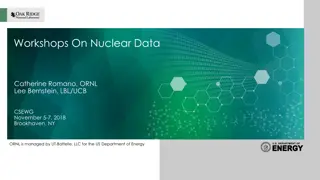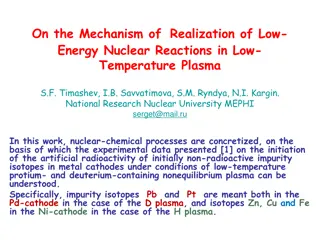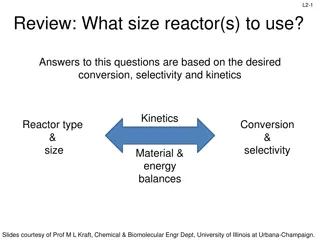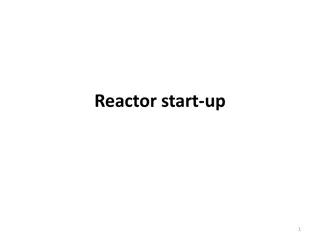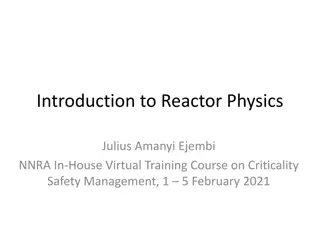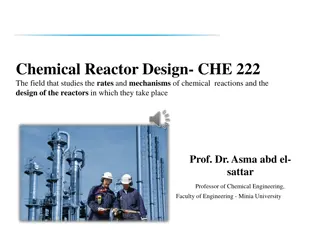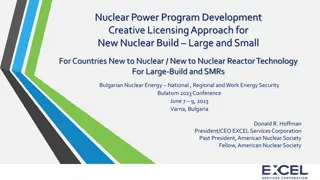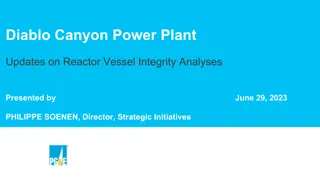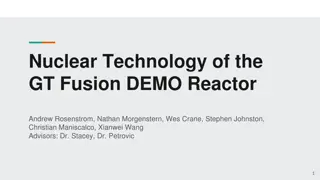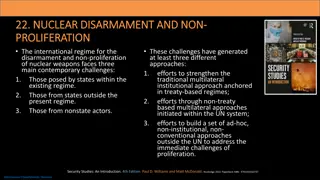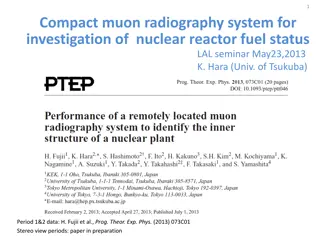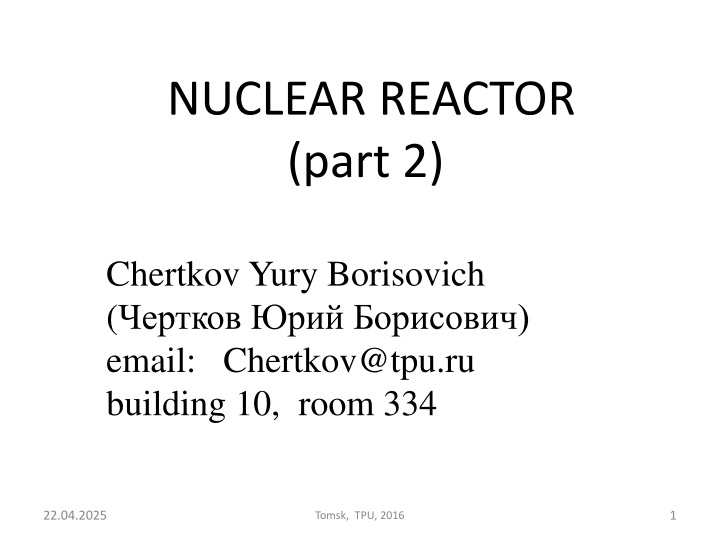
Neutron Reactions in Nuclear Reactors
Explore the fundamentals of neutron reactions in nuclear reactors, including interactions with atomic nuclei, types of reactions, and the importance of compound nuclei. Learn how free neutrons play a crucial role in nuclear processes and the transition to stable energy states.
Download Presentation

Please find below an Image/Link to download the presentation.
The content on the website is provided AS IS for your information and personal use only. It may not be sold, licensed, or shared on other websites without obtaining consent from the author. If you encounter any issues during the download, it is possible that the publisher has removed the file from their server.
You are allowed to download the files provided on this website for personal or commercial use, subject to the condition that they are used lawfully. All files are the property of their respective owners.
The content on the website is provided AS IS for your information and personal use only. It may not be sold, licensed, or shared on other websites without obtaining consent from the author.
E N D
Presentation Transcript
NUCLEAR REACTOR (part 2) Chertkov Yury Borisovich ( ) email: Chertkov@tpu.ru building 10, room 334 22.04.2025 1 Tomsk, TPU, 2016
Referenees 1. Reuss P. Neutron Physics. 2. Kurtiss L.F. Introduction to Neutron Physics. 3. DOE FUNDAMENTALS HANDBOOK. Nuclear Physics And Reactor Theory. Volume 1 and 2. 4. Beckurts K.H., Wirtz K. Neutron Physics. 5. .. 22.04.2025 Tomsk, TPU, 2016 2
1. Neutron nuclear reactions Nuclear reaction - the process and the result of interaction of the nuclei with different nuclear particles (alpha, beta particles, protons, neutrons, gamma quanta, etc.). Neutron reactions - the process and result of the interaction of free neutrons with atomic nuclei. 22.04.2025 Tomsk, TPU, 2016 3
Neutrons that make up atomic nuclei, are called bound, unlike neutrons moving in the volume of the medium outside the nuclei of atoms, which are called free. These free neutrons, colliding in the process of spatial displacement with nuclei of atoms of the medium and interacting with the latter , cause various types of neutron reactions. 22.04.2025 Tomsk, TPU, 2016 4
Light feasibility of the vast majority of neutron reactions is due to the electrical neutrality of neutrons, so that they are able to easily get into the sphere of activity of its nuclear attraction and interact with nucleons of the nucleus. This is the essence of neutron nuclear reactions. 22.04.2025 Tomsk, TPU, 2016 5
2. Main types of neutron reactions in a nuclear reactor Any neutron reaction begins with the penetration of a free neutron in the nuclear volume, in the sphere with the diameter of about 10-13cm, within which the attraction forces of the nucleons act effectively. But a stable nucleus cannot be formed from any arbitrary number of protons and neutrons. Compound nucleus, formed by the penetration of a neutron, is excited or unstable nucleus. 22.04.2025 Tomsk, TPU, 2016 6
Excited compound nucleus in this state cannot exist for a long time and tends to move to sustainable energy state. That is to get rid of the excess of potential energy. The residence time of the compound nucleus in excited state is 10-15 10 -13 s. The natural tendency of the excited compound nucleus to a stable state can be realized in various ways. As a result, there are following types of neutron reactions, the main ones are: - neutron radiative capture; - neutron scattering; - nuclear fission. 22.04.2025 Tomsk, TPU, 2016 7
3. Neutron capture Excited compound nucleus is able to keep penetrated neutron in the structure, and the excess energy to "discharge" in the form of emitted -quantum of electromagnetic radiation. The result of this interaction of the neutron with the nucleus is neutron capture with the original nucleus accompanied by the emission of -radiation, thus this type of a neutron reaction was called reaction of radiative capture. 22.04.2025 Tomsk, TPU, 2016 8
Formation of the excited compound nuclear mass Emission of Nuclear ( +1) .m.u. -quantum Neutron mass a.m.u 1 0 n Nuclear mass ( +1) .m.u. Fig. 1. Schematic representation of the radiative capture reaction 22.04.2025 Tomsk, TPU, 2016 9
All known nuclides, without an exception, are prone to radiative capture reactions in varying degrees. Types of atomic nuclei, which are the most susceptible to radiative capture, are called neutron absorbers. For example, These are strong neutron absorbers. nuclear reactors is also quite strong absorber of neutrons. 10B, 149 Sm, 135Xe, Eu, Cd, Gd. 235U, the main fuel component of vast majority of 22.04.2025 Tomsk, TPU, 2016 10
4. Scattering Formation of the excited compound nuclear Nuclear mass ( +1) .m.u. Neutron mass .m.u 0 n Nuclear mass .m.u. Neutron capture by the nucleus Emission of the scattered neutron Fig.2. Schematic representation of the nuclear scattering reaction. 1 1 0 n - If an excited compound nucleus is not able to keep penetrated neutron in its structure, natural drive of the nucleus towards sustainability can be accomplished by "pushing" captured or any other neutron from nucleus equivalent to captured neutron by the quantum properties. 22.04.2025 Tomsk, TPU, 2016 11
The only result of the interaction is that kinetic energy of the original and emitted neutrons are not the same: - the energy of the emitted neutron in most cases is lower than the energy of the original neutron. - In addition, the direction of motion of the original and emitted neutrons are also not the same. 22.04.2025 Tomsk, TPU, 2016 12
Outwardly, this interaction does not look like nuclear, but rather as an ordinary mechanical collision of a neutron with a nucleus, as a result of which the neutron transfers a part of its kinetic energy to a nucleus, thus changing its speed and direction of motion. In classical mechanics, repeated acts of such collisions are called scatterings. By analogy with the mechanical scatterings, such neutron reactions are called scattering reactions. 22.04.2025 Tomsk, TPU, 2016 13
All (without exception) known nuclides, although to varying degree, have a tendency to a scattering reaction. It is important to know nucleus of what elements have a tendency to scattering, as in a thermal reactor due to the scattering reactions there is a process of reducing kinetic energy of neutrons as they move in the medium of the core. 22.04.2025 Tomsk, TPU, 2016 14
This process is called moderation of neutrons. Therefore, nuclei - good neutron scatterers - having a reduced tendency to radiative capture , as a rule, are good neutron moderators. Nuclei of hydrogen (1H), deuterium (2D), beryllium (9Be), carbon (12C) are good moderators with weak capturing properties and strongly pronounced tendency to scattering. 22.04.2025 Tomsk, TPU, 2016 15
And one more analogy of nuclear and mechanical scattering: scattering can be elastic and inelastic, and, criteria for evaluating the elasticity of the scattering in both cases are the same: - if the sum of kinetic energies of a nucleus and a neutron before and after scattering equal to each other, ( nucleus+ neutron)before= ( nucleus+ neutron)after , scattering is called elastic. In other words, in the elastic scattering there is ordinary redistribution of kinetic energy: a neutron gives part of its kinetic energy to the nucleus, kinetic energy of the nucleus increases after scattering by the magnitude of the recoil; 22.04.2025 Tomsk, TPU, 2016 16
- if the sum of kinetic energies of nucleus and neutron after scattering is lower than their sum before scattering, ( nucleus+ neutron)before> ( nucleus+ neutron)after , scattering is called inelastic. Difference between the sums of kinetic energies before and after scattering is spent on change in internal energy of the nucleus. Excess of energy of the original nucleus in the inelastic scattering "discharges" by the nucleus in the form of emitted gamma quantum. 22.04.2025 Tomsk, TPU, 2016 17
Important regularities of nuclear scattering: - elastic scattering is, in a greater degree, characteristic of light nuclei (with an atomic mass 20) when interacting with the neutrons of relatively small kinetic energies ( 0.1 MeV); - heavy nuclei when interacting with neutrons of larger (E> 1 MeV) energies are more prone to reactions of inelastic scattering. 22.04.2025 Tomsk, TPU, 2016 18
5. Fission reaction The third way of changing excited compound nucleus into more stable formations - dividing it into two, three or even more proton- neutron combinations called fission fragments. Not all the known nuclei tend to fission, but only some (mainly even-odd) nuclei of heavy elements. Here are some of them: 233U, 235U, 239Pu, 241Pu, 251Cf, ... 22.04.2025 Tomsk, TPU, 2016 19
The most important of these nuclides is 235U - main fuel of the majority of existing nuclear reactors. energies but the best - with low-energy neutrons. The second most important fissile nuclide is 239Pu - secondary fuel in uranium reactors that is reproduced during their operation. energies but the most effective - by thermal neutrons. 235U is divided by neutrons of any kinetic 239Pu is divided by neutrons of any kinetic 22.04.2025 Tomsk, TPU, 2016 20
The third most important fissile nuclide is an even-even isotope of uranium -238U. An even number of neutrons in its nucleus gives a more robust combination than their odd number. Thanks to this fission 238U has a threshold nature: not any neutrons are suitable for the fission of 238U, but only neutrons with energies above 1.1 MeV. Is it worth it to pay serious attention to238U? - If it is possible to build reactors with 235U as a fuel, since it's so good! 22.04.2025 Tomsk, TPU, 2016 21
But: - firstly, uranium-238 prevails in nature: a natural mixture of uranium isotopes contains 99.28% 238U and only 0.71% 235U; - isotope separation for obtaining pure or highly enriched 235U is very energy intensive; -238U is an original raw nuclide from which secondary fuel -239Pu is reproduced in the operating reactor. 22.04.2025 Tomsk, TPU, 2016 22
This leads not only to tolerate the unavoidable presence of 238U in the reactor, but also to think about how to organize in the reactor the process of the most efficient conversion of 238U into 239Pu for obtaining and use for generating energy. Fission reaction is the most important and practically significant of the three above- mentioned neutron reactions. 22.04.2025 Tomsk, TPU, 2016 23
A nuclear reactor is essentially designed and built for the implementation of a self-sustaining fission chain reaction, and reactions of radiative capture and scattering are forced to be necessary or unavoidable, occurring parallel and simultaneously with the fission reaction. 22.04.2025 Tomsk, TPU, 2016 24
6. Another three neutron reactions Firstly, it is type of (n, p) reaction - that is, a neutron reaction terminated by the emission of a proton. Formation of the excited compound nuclear mass Nuclear ( +1) .m.u. Neutron mass .m.u and charge z 0 n Nuclear mass .m.u. and charge (z-1) Neutron capture by the nucleus Emission of the proton Fig. 3. Schematic representation of the (n,p) reaction. 1 1 1 p 22.04.2025 Tomsk, TPU, 2016 25
Secondly, this type of (n,) reaction - that is, the reaction terminated by the emission of excited compound nucleus of an -particle (devoid of electron shell of the nucleus of an atom of helium 4He), which resulted in the mass number of the resulting nucleus is reduced by 3 a.m.u compared with the mass of the original nucleus, and proton charge is reduced by 2 units. ( +1) . . . . . z 1 0 n ( -3) . . . (z-2) - .4. (n, ). 4 2 22.04.2025 Tomsk, TPU, 2016 26
Finally, this type of (n, 2n) reaction - that is, the reaction with the emission of excited compound nucleus of two neutrons, resulting in the formation of an isotope of the original element with mass one unit less, compared to the mass of the original nucleus. Formation of the excited compound Nuclear nuclear mass ( +1) .m.u. Neutron mass .m.u and charge z 0 n Nuclear mass ( -1) .m.u. and charge z Neutron capture by the nucleus Emission of two neutrons Fig. 5. Schematic representation of the (n,2n) reaction. 1 1 0 n 22.04.2025 Tomsk, TPU, 2016 27
22.04.2025 Tomsk, TPU, 2016 28


